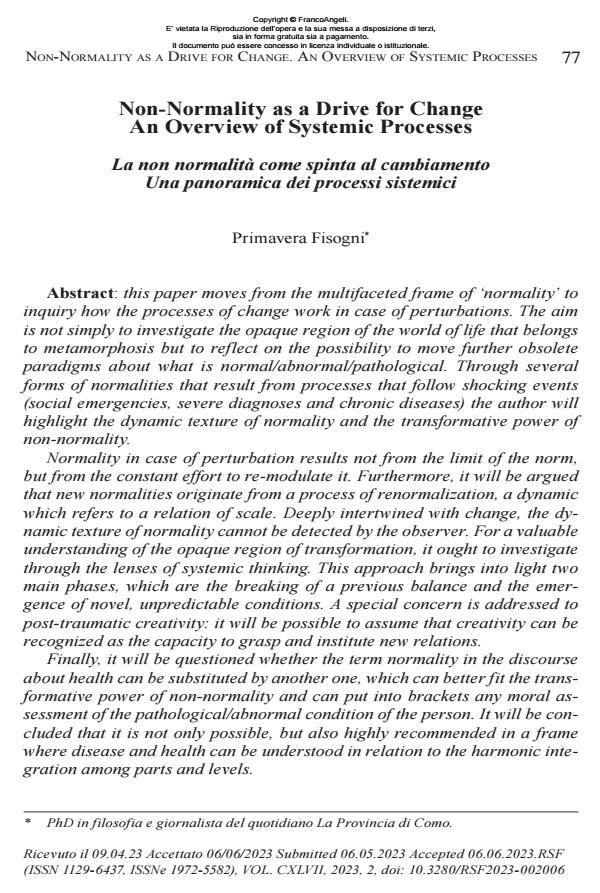La non normalità come spinta al cambiamento Una panoramica dei processi sistemici
Journal title RIVISTA SPERIMENTALE DI FRENIATRIA
Author/s Primavera Fisogni
Publishing Year 2023 Issue 2023/2
Language English Pages 21 P. 77-97 File size 711 KB
DOI 10.3280/RSF2023-002006
DOI is like a bar code for intellectual property: to have more infomation
click here
Below, you can see the article first page
If you want to buy this article in PDF format, you can do it, following the instructions to buy download credits

FrancoAngeli is member of Publishers International Linking Association, Inc (PILA), a not-for-profit association which run the CrossRef service enabling links to and from online scholarly content.
this paper moves from the multifaceted frame of ‘normality’ to inquiry how the processes of change work in case of perturbations. The aim is not simply to investigate the opaque region of the world of life that belongs to metamorphosis but to reflect on the possibility to move further obsolete paradigms about what is normal/abnormal/pathological. Through several forms of normalities that result from processes that follow shocking events (social emergencies, severe diagnoses and chronic diseases) the author will highlight the dynamic texture of normality and the transformative power of non-normality. Normality in case of perturbation results not from the limit of the norm, but from the constant effort to re-modulate it. Furthermore, it will be argued that new normalities originate from a process of renormalization, a dynamic which refers to a relation of scale. Deeply intertwined with change, the dy- namic texture of normality cannot be detected by the observer. For a valuable understanding of the opaque region of transformation, it ought to investigate through the lenses of systemic thinking. This approach brings into light two main phases, which are the breaking of a previous balance and the emer- gence of novel, unpredictable conditions. A special concern is addressed to post-traumatic creativity: it will be possible to assume that creativity can be recognized as the capacity to grasp and institute new relations. Finally, it will be questioned whether the term normality in the discourse about health can be substituted by another one, which can better fit the trans- formative power of non-normality and can put into brackets any moral as- sessment of the pathological/abnormal condition of the person. It will be con- cluded that it is not only possible, but also highly recommended in a frame where disease and health can be understood in relation to the harmonic inte- gration among parts and levels.
Keywords: normality, normalization, renormalization, change, systemic thinking, emergences, creativity.
Primavera Fisogni, Non-Normality as a Drive for Change An Overview of Systemic Processes in "RIVISTA SPERIMENTALE DI FRENIATRIA" 2/2023, pp 77-97, DOI: 10.3280/RSF2023-002006